
Durham wheat for making bread
Can one make bread with Durham wheat. Have any of you tried it? I think it may make for chewy crumb.
Thanks

Can one make bread with Durham wheat. Have any of you tried it? I think it may make for chewy crumb.
Thanks

I have made Peter Reinhart's Poilane-style miche many times, but this was my first attempt at Daniel Leader's version. The formulas are different in a number of ways. Leader uses autolyse, which Reinhart does not, and does not use cold retardation of either the starter or the formed miche, which Reinhart does. Leader uses a higher hydration dough and folding an hour into bulk fermentation.
Leader's instructions for this formula contain at least one error, in the secion on making the whole wheat starter. His instructions for adding the starter to the dough are confusion in this formula as in others.
Rather than using a mixture of bread flour and whole wheat in the final dough, I used 400 grams of first clear flour and 100 grams of whole wheat. (I used to prefer all first clear flour for Reinhart's miche, but KA's first clear flour seems to be somewhat lower extraction recently.) The miche was proofed in a linen-lined wicker banneton, which I am loving.
Two hours out of the oven, the flavor was lovely. I like the flour mix I used - just enough whole wheat flavor. It was somewhat less sour than Reinhart's version in my hands, presumably due to the lack of cold fermentation, I assume.
Photos to follow ...
David

Working from home has its disadvantages: it's all too easy to blur work into home-life, you're somewhat isolated from co-workers, and it's tempting to try to do chores when work is slow.
But bread baking poses no problems at all. Most of bread baking, especially when you use the stretch and fold method to develop dough instead of traditional kneading, consists of 2-3 minute bursts of activity separated by long periods of waiting. The trouble, of course, is that the timing of those little bursts of activity is really, really important. Working from home, the kitchen is always just a few steps away from my computer, and doing the work of making bread takes about as much time as going to fetch a fresh cup of coffee.
Lately, I've been doing a lot of sourdough baking, even when the bread itself isn't truly a sourdough bread. For instance, here's my results from baking Peter Reinhart's Mash Bread, from his new (and fabulous) book, Peter Reinhart's Whole Grain Breads. 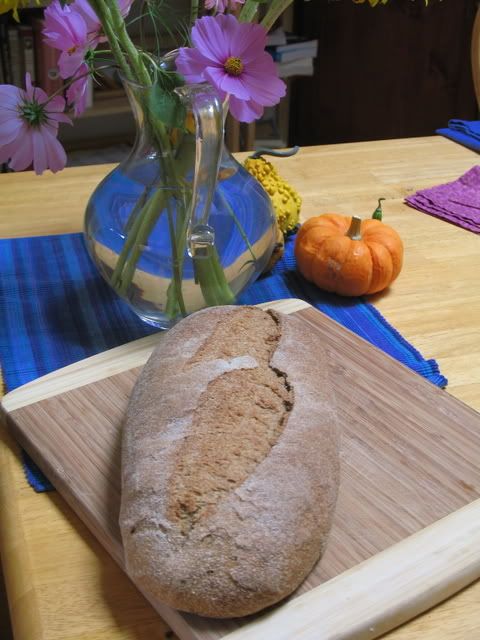
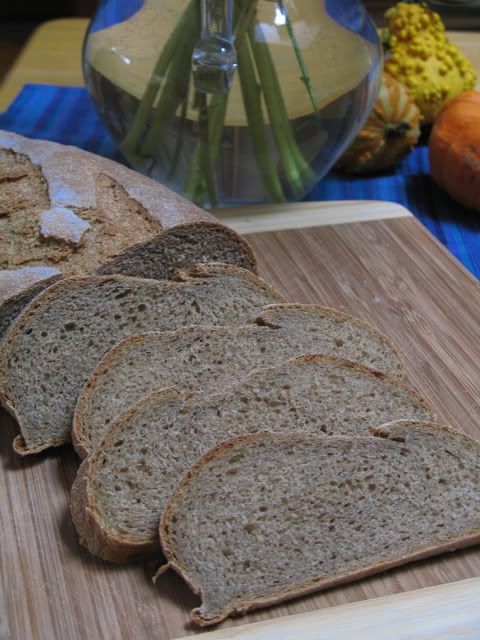
The sweetness of the bread was really surprising, and I was astonished by how much oven spring I got. It's easily the best I've ever gotten from a 100% whole grain bread. Unfortunately, I was in a hurry and didn't let the sourdough mature fully, so the flavor was less than I'd expected. In short, sweet, but bland. I'm eager to try it again, though, and next time I'll let the sourdough fully ripen, which is especially important, since the sourdough is used almost exclusively for flavoring rather than leavening. If you want to make this bread, I'd suggest heading over to Bill Wraith's excellent write-up.
I had some starter left over, so I made up some sourdough pizza dough -- two of the doughballs went in the freezer, while the others went into the fridge so that I could make them up for dinner the next night. Probably two of the best pizzas I've made. A woman at the Corvallis Farmer's Market was selling wild chantrelle mushrooms, so I got some, sauteed them in a bit of butter, and plopped them on the pizza. They were great, along with some black olives and turkey-chicken sausage: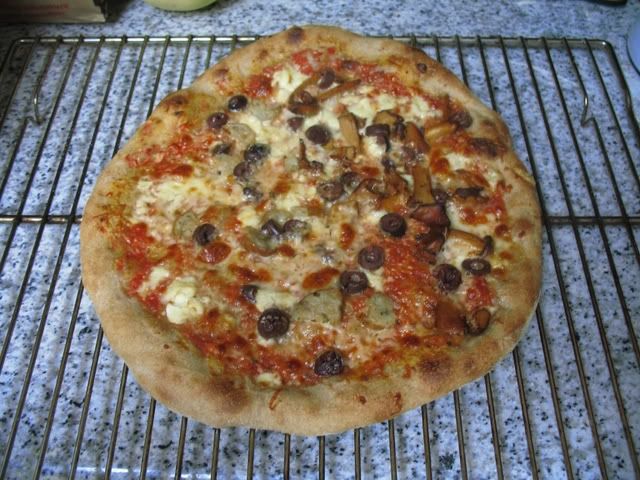
The crust was nice and holey!
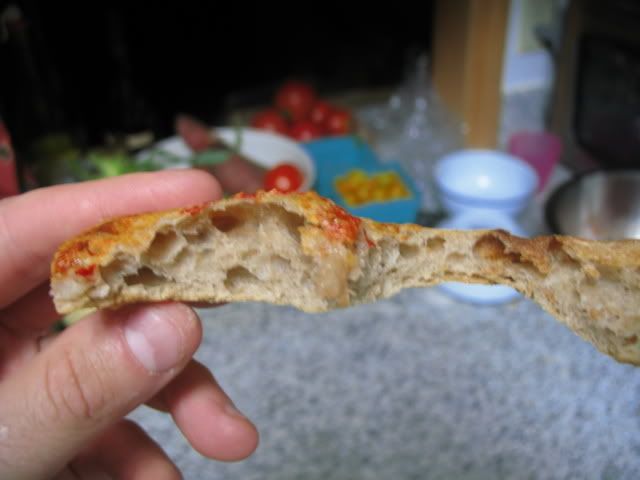
Here's how I made it:
Formula


This is a recipe that Kenneth, a long-time poster to rec.food.sourdough, has posted a few times in response to requests. I made it this weekend and can safely say it's delicious. Tangy, but not overpoweringly so, with a smooth crumb that, though not full of big holes, is nevertheless a moderately light bread. It sprung well in the oven. In fact, it reminded me of some of the better Desem breads I've made. The hydration of this loaf is 68%, so one could go higher, I'm sure, and the salt is higher than usual at 2.5%, but the bread did not taste overly salty.
On a side note, I'm beginning to think my quest for holey, super hydrated whole wheat is misguided. The breads are no more tasty, in my experience, and though the crumb is more open, the high hydration has made the loaf flatten out considerably in the oven.
Back on topic. Kenneth, I believe, uses an authentic Poilane starter in his bread (I used Carl's) and emulates the high-extraction flour that Poilane uses through a combination of AP flour and freshly ground whole wheat (the loaf is about 40% white flour). He also uses 30% whole spelt flour, based on this page on Poilane's Web site.
How well does it imitate a true loaf from Poilane? I have no idea. The last time I was in France was 17 years ago when I was a not-so-well-heeled student, and today ... well, I'm not willing to part with the kind of cash it would take to have a loaf delivered to me from across the Atlantic.
All I can say is, it makes a nice loaf of bread. Here's my result:

And here's Kenneth's recipe, or at least, the version of it that I used:
Day 1, 9:30pm 474g Water + 120g starter + 236g coarse whole wheat, ferment at 69F.Of course, I fiddled with the recipe. First, I didn't knead on Day 2. Instead, I mixed it up and then let it ferment for 2.5 hours. I gave it a fold at 1 hour, 45 minutes and then another 45 minutes. Then, I popped it in the fridge. When I baked it, I did use a preheated oven, stone and steam, but I feel certain that a cold start would do fine as well. I baked at 460.
Day 2, 7:30am add 65g coarse rye, 254g KA AP flour, 170g wholespelt flour, 20g salt.
Knead fully, then refrigerate 24 hours. Then, form boule, ferment at 69F for 5 hours.
Slash, then bake at 490F for 35 minutes, the first 15 minutes with steam...

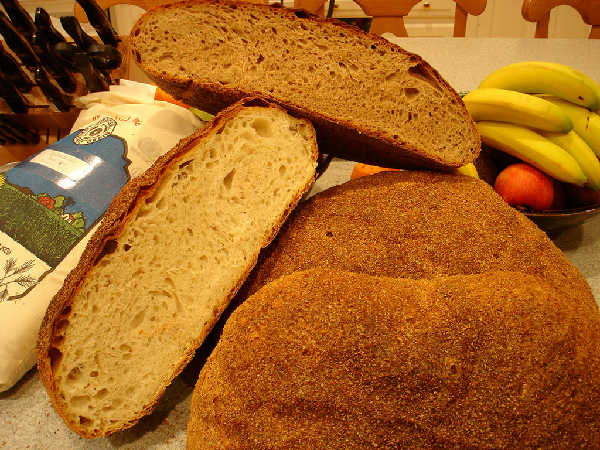
Daniel Leader's Local Breads has a fascinating story of his visit to Genzano, where he saw them make large, almost charred looking, bran dusted breads raised with a biga naturale, an Italian firm sourdough levain. I enjoyed hearing about his visit with Sergio, while they mixed, raised, and loaded 64 very large loaves into a wood-fired oven. Now that I have a brick oven in my back yard, I thought I'd give a try at making these loaves in the size he says he observed at the bakery he visited. He says they created approximately 8 pound loaves that were loaded eight at a time into an eight foot long by one foot wide by about 4 inches tall box with divisions in it for eight loaves. Thanks to Zolablue for doing this recipe as shown in Leader's book and writing about it in her blog, which provided inspiration as well as lots of information and photos.
I've included some photos of the process and spreadsheets for the high extraction flour loaf in html and xls format and for the white flour loaf in html and xls format.
I only did two loaves of 8 pounds each, which I proofed in a 26 inch by 17 inch by 4 inch roasting pan, and then baked in my brick oven, which is a dome 37 inches in diameter - enough room for two of these loaves. The dough is very wet and is kneaded in a mixer at increasing speed for over 20 minutes or more to fully develop the gluten. The dough is hard to handle, as it is very soft, sticky, and puffy.
There are two styles of this bread, one with a high protein white flour and one with a high extraction flour. I used Heartland Mills Strong Bread Flour for the white flour loaf and Heartland Mills Golden Buffalo for the high extraction flour.
Levain
The levain was mixed the night before and allowed to rise overnight at room temperature. The amounts are such that by mixing the white flour levain at about 10PM and the high extraction flour levain at 11:30PM, the white flour levain would be ready at 9:00AM the next day and the high extraction levain would be ready at 10:00PM the next day, allowing me to mix them successively in the morning with my DLX mixer such that both loaves would be ready to bake at the same time later on the next day. The high extraction flour rises more quickly than the white flour, so it is being mixed later to account for that difference.
Dough
According to Leader, the dough is mixed for a long time at high speed. I used a DLX mixer, first at a low speed to mix the ingredients for about 10 minutes, then at medium speed for about 8 minutes, then at high speed for another 4 minutes.
The dough is supposed to be very soft and wet. I had to add a little flour to the white flour loaf, as it was so wet, it wouldn't come together, even after 20 minutes of kneading. I had to add some water early in the mixing of the high extraction flour loaf, as it was clearly too stiff to begin with. Eventually, they were both fairly wet and gloppy, but with reasonable gluten development. I ended up folding the white flour dough a couple of times and the high extraction flour once. It seemed necessary to get some additional gluten development later on.
The inoculation for this recipe is 20% fermented flour to total flour weight, which is a little lower than the recipe in Local Breads (30% fermented flour). The idea was to let it rise a little longer to get more sourdough flavor in the dough. I've had better results starting at inoculations below about 25% with my starter in any event. For the same reasons, the amount of instant yeast was reduced to only 5 grams in 2Kg of total flour. My plan was to let the dough rise for about 3.5 hours in bulk fermentation and about another 2.5 hours in final proof. However, it went faster, as I forgot how warm the dough would be and how long it would stay warm due to the long machine kneading and the large volume of the dough. The dough rose almost too quickly, even with the lower inoculation and amount of instant yeast. I would consider reducing the yeast even further in a subsequent attempt, to match the timing I wanted for the sourdough fermentation with less need to punch down the dough.
Bulk Fermentation
Each dough was placed in a rising bucket. The white flour dough was folded twice, at one hour intervals. The high extraction flour dough was folded once two hours after mixing.
Final Proof
The loaves were placed seam side up in a large roasting pan measuring 26x17x4 inches. A piece of wooden board was placed between the loaves and separate couches were placed on each side of the board to facilitate lifting each large piece of dough out onto the peel. The couches were dusted with KA white wheat bran, which worked beautifully as a "teflon" dusting. After about 2 hours and 15 minutes, the loaves seemed ready. To place them on the peel they were lifted in the couche and basically "dumped" onto the parchment lined and bran dusted peel unceremoniously. They spread out beyond the edges of my 16 inch peel, so I had to quickly but gently fold the edges underneath to get the loaves to fit on the peel, which didn't sound completely inconsistent with the description Leader gave of the process followed in the Italian bakery he visited. He said the loaves were very soft and gloppy, were handled minimally, and quickly moved from one spot to another. I'm sure it was far more graceful than what I ended up doing on my first shot, but it did seem to work. The basic advice here is plow ahead, don't look back, don't waste time worrying about the shape or the tightness of it. This is a rustic loaf, after all.
Bake
The oven hearth floor was raised to about 525F and then the flame was put out, the oven door sealed, so the temperature inside could equilibrate and drop over the course of the last hour of the final proof. The loaves were dumped on the peel, adjusted minimally in shape as needed, and transferred into the oven in quick succession. The oven and loaves were sprayed with a fine mist to generate steam, and the oven door was sealed with a wooden door covered with damp towels.
The kitchen oven equivalent would be to preheat to about 450F with baking stone, and use a skillet with water or other steaming method, and drop temperature to 400F immediately shortly after putting the loaves in the oven.
The loaves were rotated after about 20 minutes, and the steam was removed from the oven by replacing the towel covered door with a metal door positioned to allow some air flow out the chimney.
The total bake time was 1 hour and 20 minutes, but the oven door was open and the outside air was fairly cold today, so the hearth temperature was only about 400F and the air temperature about 350F for the last 20 minutes. The idea was to make sure the loaf was fully baked inside, since they are large, wet loaves. The internal temperature was about 207F at the end. In retrospect the oven could have been a little hotter, as they didn't get quite as charred as was intended.
Results
The loaves have a nice color but aren't quite as dark as Zolablue's loaves. My sense of the right temperature for different situations with the new brick oven is still developing. The crumb is just what I like for both loaves, moist with irregular hole structure and a mild but distinct sourdough flavor. The white flour loaf, which may have been made a little too wet, had fewer large pockets and less crust separation than expected, given the excess hydration. As a high extraction flour miche, the high extraction flour Genzano loaf may become a standard, although the Thom Leonard Country French made with Golden Buffalo is similar and also a wonderful miche.

I found the recipe for these Spanish olive oil wafers in Penelope Casas' La Cocina de Mama: The Great Home Cooking of Spain.
These are a great way to use up a little bit of extra pizza or bread dough and they are really delicious. Thin and flaky and spiced with anise and sesame seeds. There is sugar on top (which could be omitted for a less sweet wafer); no sugar in the dough.
Click here for the recipe.


Hello! Just wanted to show the machine I use to grate nut meats into flour. Same can be used for sunflower seeds, hard bread (crumbs) hard cheese, etc. The nuts are cut and not mashed or pressed so they remain fluffy and dry.
Here in Austria, in many recipes, the addition of nuts (as a flour) and such is done with an electric grater making a very fine and light "flour" not to be confused with chopped nuts or nut butters (what you would get if you milled nuts). Imposible to do on a grating box or by hand. I also use my electric grater to make fluffier bread crumbs. One could come close with a crank grater using the fine hole setting.
When I grind my own, I carefully look over the oil or fat content of a non-Austrian recipe and decide if additional fat is needed, the nuts themselves adding a fair amount of oil.
Here is the Exploded view of the machine.

Electric Grater
 Electric Grater
Electric Grater


 Walnut Flour
Walnut Flour
See the little curls of nut? This is what keeps baked goods from getting heavy or fatty.

Grated walnuts very close up
Mini O

For those of you who grind your own wheat, what type of wheat berries do you prefer? Winter or spring wheat? Red or white? Do you prefer different types of wheat for diferent types of bread?
I just purchased a Nutrimill grain mill and bought 25 lbs of organic red winter wheat from Utah from my local health food store. Also purchased 25 lbs of organic Canadian rye. I haven't used the wheat yet, but the rye has been wonderful. Would be interested in your experiences. Thanks! Liz

Does anyone know exactly what are the small blisters that surround our long fermented sourdough breads are. I normally take it to mean a positive thing as most wholemeal products need this to get rid of phytic acid.

Mini O - L_M & Marianna
Update - Momma starter is still just a tad bit more "tangy" then "The Baby "
But I feed them three times to day - almost tripled in volume in acouple of hours - Made reg SD and Mike Avery`s Bohemian Rye that is in his download bread work sheet - listed as "sample sheet" and divided it in two to make two marble ryes. They were decent but could have been a little more on the rye sour taste.
On the worksheet he lists 2 cups starter - I just used the reg. SD starter that I took out befor feeding -
My Question is this - when I remove/discard befor feeding - can I take some of it and turn it into a rye sour by doing a 1 : 2 : 3 build - one part sour - two parts H2o - three parts rye flour -or a 1 : 1 : 3 there by turning it into a stiff /stiffer starter - and then do I feed it rye flour when I feed it or just bread flour .
Thanks
Slide__Out
P.S.S getting a digital camera this week-end will have pic`s of starters and maybe some breads .